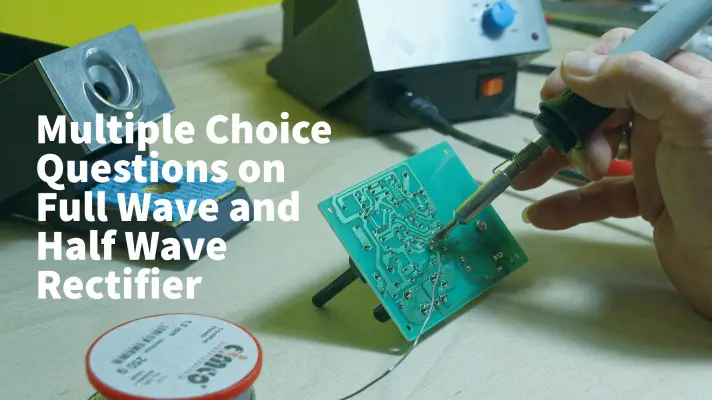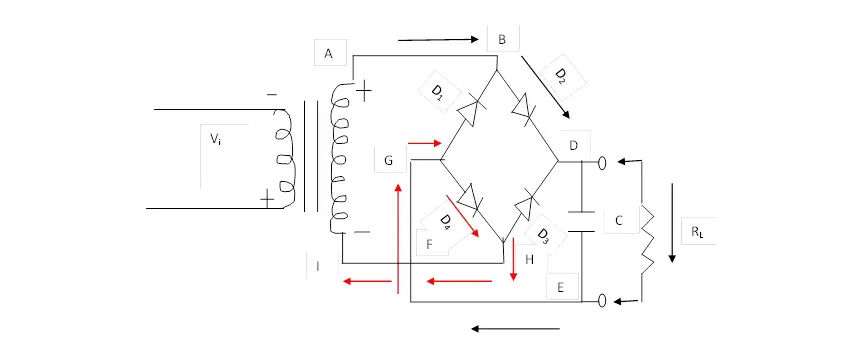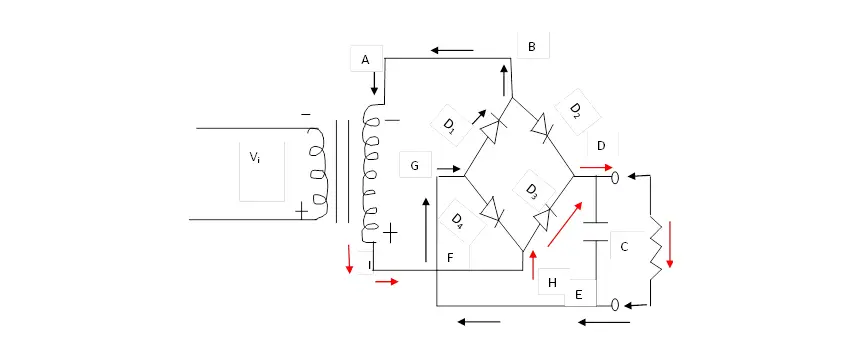Here, I will display some Multiple-Choice Questions on Full Wave Rectifier and Half Wave Rectifier. Hence, if you are searching for MCQ questions on Rectifiers, you are in the proper place where you will get varieties of MCQs on Full wave Rectifiers and Half Wave Rectifiers.
There will be a quiz that you should not miss. I hope that you will get interested in both reading the MCQ Questions as well as appearing for the test.
Now, let us move into the MCQ section.

MCQ Questions or Viva Questions on Rectifiers
- which rectifier has more efficiency?
- half wave rectifier
- full wave rectifier ✔️
- What rectifier does?
- converting DC to AC
- converting AC to DC ✔️
- none of these
- From the battery charger, we get ____.
- AC
- DC ✔️
- none of these
- The average DC voltage across the load is
- 0.437 Vmax
- 0.537 Vmax
- 0.637 Vmax ✔️
- 0.737 Vmax
- Maximum efficiency of Half Wave Rectifier is:
- 25%
- 41% ✔️
- 65%
- 85%
- Maximum efficiency of Full Wave Rectifier is:
- 25%
- 41%
- 65%
- 81% ✔️
- In which rectifier value of ripple factor is less?
- Full wave rectifier ✔️
- Half wave rectifier
- can’t say
- Ripple factor of Half Wave Rectifier is:
- 3.21
- 2.21
- 1.21 ✔️
- 0.21
- Ripple factor of Full Wave Rectifier is:
- 0.483 ✔️
- 0.383
- 0.283
- 0.83
- Ripple factor =_____
- Irms / Idc ✔️
- Irms – Idc
- Irms + Idc
- Irms * Idc
- The _______ stores the electric charges.
- transformer
- capacitor ✔️
- resistor
- none of these
- 1 coulomb means ____ numbers of electrons.
- 3.25 x 10^18
- 4.25 x 10^18
- 6.25 x 10^15
- 6.25 x 10^18 ✔️
Quiz on Rectifiers
Here is the quiz for you on Full-wave and half-wave rectifiers.
Overview
If you want further clarification against the multiple-choice questions, you may read the following text.
We will suggest that first, you read the text and then re-appear for the Full-wave and half-wave rectifier MCQ test to know your progress.
Short questions on ‘Full wave and half wave rectifier’
Here are the short questions. You should read it first and then give the test on “Full-wave and half-wave rectifier MCQ”.
What is rectifier?
The power coming from the power grid is an alternating current. But the batteries used at our home or battery chargers require direct current (DC). Within the battery charger, a rectifier is there. It helps in converting AC to DC.
Therefore, the rectifier is an electronic device that converts AC current into DC current.
What is rectification?
The way how we convert the AC current into DC current with the help of a rectifier is known as Rectification.
What are the types of rectifier?
Rectifiers are of mainly two types- Single phase and 3 phase. Each is of two types – controlled and uncontrolled. Controlled and uncontrolled rectifiers again can be divided into two types- half-wave and full-wave.
What is a full-wave rectifier?
A full-wave means two numbers half-waves of a cycle. When the rectifier converts the AC current of both the half-waves of the cycle into a DC current, the rectifier is a full-wave rectifier.
What is a half-wave rectifier?
When the rectifier converts the AC current of one half of the cycle into a DC current, the rectifier is the half-wave rectifier.
What is the principle of a full-wave rectifier?
The full-wave rectifier converts AC current into DC fully. It is of two types- center-tapped full-wave rectifier and full-wave bridge rectifier.
What are the advantages of a full-wave rectifier?
The advantages of a full-wave rectifier are as follows:
Rectification efficiency is higher than that of a half-wave rectifier. It is almost twice a half-wave rectifier’s efficiency. The efficiency of the half-wave rectifier is 41% and the maximum efficiency of the full-wave rectifier is 81.2%.
The DC output voltages and currents available from the full-wave rectifier are double of the half-wave rectifier.
The output of the full-wave rectifier fluctuates less than that of the half-wave rectifier.
What are the disadvantages of a full-wave rectifier?
The full-wave rectifier needs more diodes than that of the half-wave rectifier.
The full-wave rectifier needs more space than that of the half-wave rectifier.
The design of a full-wave rectifier is more complex than that of a half-wave rectifier.
Can you convert AC to Dc?
Yes, we can convert the AC current into DC current with the help of a rectifier.
What is the output voltage of a full-wave rectifier?
The voltage developed in the output waveform is unidirectional. The average DC voltage across the load is 0.637 Vmax. The output voltage varies from zero to a certain maximum value.
What is a ripple factor?
Fluctuation in voltage and current occurs at the output of the rectifier. This fluctuation is expressed by the term – ‘ripple factor’.
Mathematically, ripple factor =( RMS value of AC component at the output of the rectifier / average value of the same component at the output of the rectifier).
Ɣ =Irms/Idc
Or, Ɣ = sqrt of [{(Vrms/Vdc)^2}-1]
Ripple factor is a dimensionless quantity, the value of which is always less than 1. The ripple factor for a half-wave rectifier is 1.21.
We can reduce the ripple factor by using a capacitor filter.
The ripple factor of a full-wave rectifier is 0.483.
What is Form factor?
The form factor is the ratio between the RMS value and the average value of the AC component.
Form factor = (IRMS/IAVG)
={(Im/sqrt 2)/(2Im/π)}
The form factor of a half-wave rectifier is 1.57.
The form factor of a full-wave rectifier of a sine waveform is 1.11.
Output voltage
Output voltage VDC= (VSMax/π)
For, full-wave rectifier- Output current =0.637 IMAX
Output current= 0.9 IRMS
Where, VSMax is the maximum amplitude of the secondary voltage.
How to make a full wave rectifier?
Full wave rectifier diagram

Positive half of the Full wave bridge rectifier and the current flow path is ABD2DCEFGHI

Instruments required and function of the instruments
Step down transformer
What is a transformer?
A transformer is an electrical device that is used for changing the voltage in a circuit as per the requirement of the appliances without affecting the total electric power.
How many different types of transformers are there?
There are two different types of transformers depending on their usage. One is a Step-up transformer and the other one is a Step-down transformer.
How does a transformer work?
The coils or turns which are connected with the Alternating current source are the primary turns or primary coils or primary windings. In this diagram number of primary turns is Np.
The coils or turns which are connected with the output side of the transformer are secondary coils or secondary turns or secondary windings. In this diagram, the number of secondary turns is Ns.
The voltage in the input side of the transformer is the primary voltage (Vp) and the output voltage is the secondary voltage (Vs).
The primary voltage excites the primary windings. As a result, an alternating current flows through the primary winding. This creates an alternating magnetic flux. This flux passes through the magnetic core and completes its path.
When the flux passes through the entire path, it induces electromagnetic forces in the secondary winding as per Faraday’s Law.
The amount of the voltage in the secondary winding depends on the number of coils or turns(Ns) through which the flux passes.
The relation between Np and Ns is:
Vp/Vs = Np/Ns
Thus, we are getting the voltage on the output side of the transformer.
In the above diagram as Ns<Np, Vs< Vp
So, this transformer reduces the voltage. Hence, it is step down transformer.
Diodes
Please click on the following link to know about Diodes.
https://multiplechoicequestion.com/mcq-on-semi-conductor-diode/
Capacitors
The capacitor is an electrical device. It stores electrical energy. It has two terminals. You can wire it with an electrical circuit for storing the charge. When power is on and the current flows, the plates of the capacitor get charged. It has two plates. One plate gains a positive charge and the other plate gains a negative charge. These charges are of an equal amount.
These two plates which act as conductors are separated by a dielectric or an insulator.
Thus the capacitor stores the electric charges.
At 1 volt, a 1 Farad capacitor can store 1 coulomb of current. 1 coulomb means 6.25 x 10^18 numbers electrons.
When 1 coulomb of electrons flows in 1 second, 1 ampere current is produced.
Resistor
The resistor is a passive electrical device used for resisting or reducing the current. It has two terminals. This property of reducing or limiting the current is called resistance.
The capacity of a resistor is expressed in ohm(Ω).
Solder
https://multiplechoicequestion.com/mcq-on-soldering-and-brazing/
Please click on the above link.
Soldering iron
Please click on the above link.
Vero board
There are three different types of boards available in the market- Vero board, plain circuit board, and printed circuit board.
Vero board is the simplest version of the circuit board. The Circuit board material is copper strips. These copper strips are on an insulating bonded paper board used for making the electronic circuits.
A plain circuit board is one circuit board where wire connections exist. You have to put the electronic component and also you have to link the component with the wires.
Printed circuit board where the allocation of the components has also been printed and fixed along with the connection. You have to simply put the component at those particular locations.
Procedure
Take the Vero board and fix the four diodes.
Make the connection within them.
Connect the input side of the transformer with the positive side of one diode. Then connect the balance diodes as per the diagram by soldering.
Place the capacitor and resistor and connect them as per connection.
Switch on the power source.
Now check the output voltage. Draw the output waveform and match it with the theoretical drawing.
The multiple-choice questions mentioned here are the basic questions from the “full-wave rectifier”. This will help you in clearing the viva during the semester examination. Good luck!


